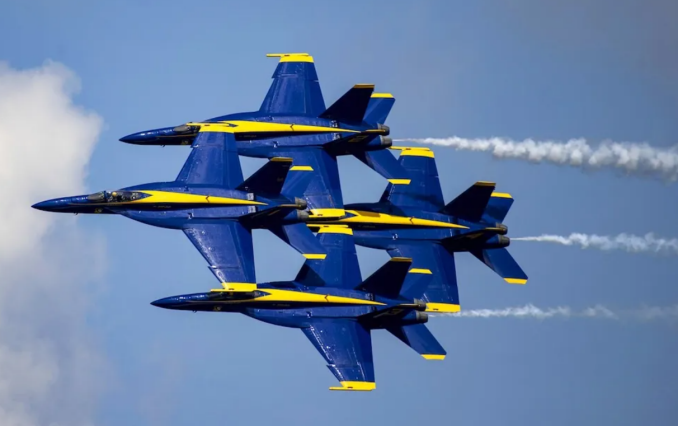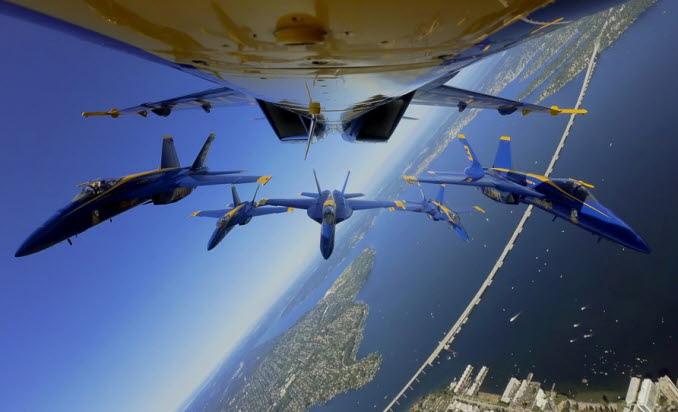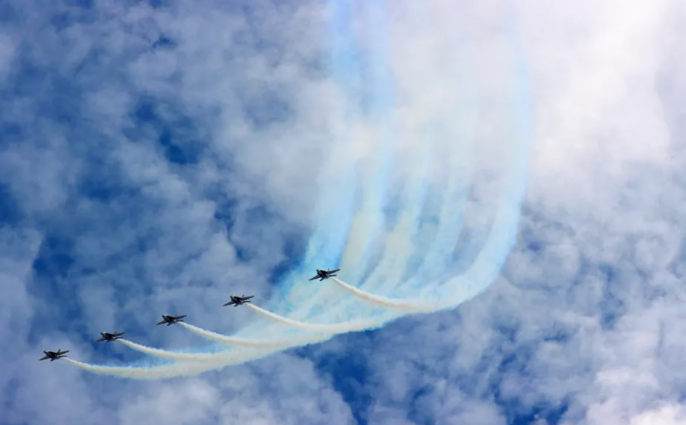Documentary film “The Blue Angels”, which was released on Amazon Prime a few days ago after getting a limited theatrical release in US, is basically your typical promotional film with lots of terrific technical stuffs to admire. While I was watching the documentary during this Sunday afternoon, I often wondered how many of its memorable moments were actually shot, and that was almost enough to make me overlook its by-the-book promotional presentation.
The main subject of the documentary is the US Navy and Marine Corps flight squadron called “The Blue Angles”, which was established shortly after the end of the World War II. For more than 75 years, this flight exhibition squadron has steadily done a number of heart-stopping airshows here and there in US, and the documentary focuses on how the veterans and newest members of this squadron go through another highly demanding year.
At first, we observe the members of the squadron preparing a lot before their another season is about to begin in January. They practice together two or three times every day for honing their aviation skills more and more, and they gladly show and tell us about how precise they must be in their flight maneuvers to demonstrate in public. In case of one particular flight maneuver, their jet fighters must be very close to each other in addition to being aligned well together, and there is an amusingly intense moment when the members train themselves on this flight maneuver together as visualizing it together in their minds. This moment may look a bit ridiculous on the surface, but they are totally serious in every imagined movement of theirs, and you will admire more of their sheer professional dedication.
Once these pilots are up in the air, the documentary rolls out a series of astonishing shots which are certainly worthwhile to watch via big screen. Cinematographer Jessica Young and her two ariel directors of photography did one heck of job in closely and vividly conveying to us how it feels like being inside one of these speedy jet fighters, and you may not be surprised to know that the cinematography of the documentary was helped a lot by what was specially developed for that amazing cinematography of “Top Gun: Maverick” (2022). As a matter of fact, Glen Powell, who played one of the key supporting characters in that film, actually served as one of the producers of the documentary.
Compared to these awesome visual moments of the documentary, its more down-to-earth moments look relatively trite in comparison. We get to know a bit about several members of the squadron, but they are more or less than your typical model pilots mostly defined by their pride and dedication. At one point, we get some glimpse into the family life of one of the squadron members, but this private moment feels a bit too neat in my humble opinion, and the same thing can be said about the part focusing on the apparent risks of airshows and some human loss caused by these big risks.
Anyway, the documentary keeps impressing us with its technical prowess, and, as a nerdy guy who has a deep aversion to height, I often cringed more than once during my viewing. I still remember when several jet fighters get extremely close to each other as orderly flying together as required, and I cannot possibly forget several dizzy scenes where the squadron members deliberately turn their jet fighters upside down as the part of their maneuvers. If I had watched the documentary in a big IMAX theater as intended by director/co-editor Paul Crowder, I would definitely be on the edge of my seat from time to time.
Needless to say, the new members of the squadron go through lots of rigorous selection process just like its predecessors, and we get some observation from this highly selective procedure. Every year, many top candidates around the country apply for that, and the selection committee certainly must be careful and thoughtful about which candidate is the best one to train and depend on. We subsequently see how the eventually selected pilots go through their following training process, which surely tests a lot on whether they do have the right stuffs for those risky airshows. For example, they all have to do endure the higher levels of gravity one by one, and, not so surprisingly, most of them get fainted during their first trial.
The documentary also briefly observes how these and other pilots of the squadron are constantly supported by numerous mechanics and technicians in the squadron. Just like the pilots, all of these mechanics and technicians are confident and dependent in one way or another, and their close personal/professional relationships with the pilots are evident from how they closely work along with the pilots from the beginning to the end.
In conclusion, “The Blue Angels” did its job as much as intended, and I appreciate that to some degree, but I wish it would go beyond the merely slick promotion of its main subject (With those frequent slow-motion shots, it often feels like your average Michael Bay flick, by the way). Now I am reminded of that famous question from late American film critic Gene Siskel: “Is this film more interesting than a documentary of the same actors having lunch?” Yes, it may be more interesting to watch a documentary on how hard the members of the cinematography department of “The Blue Angels” worked together, and I will gladly watch it if it ever comes out someday.










